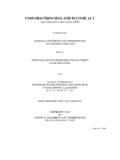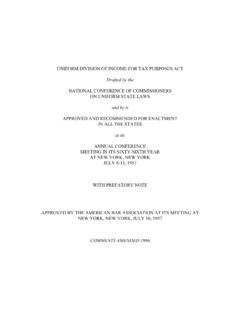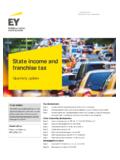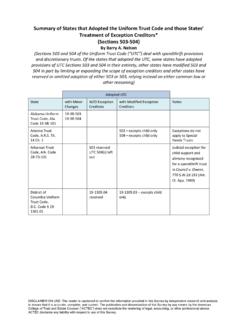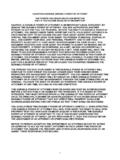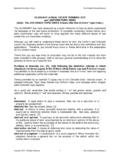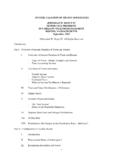Transcription of IMPLEMENTING TOTAL RETURN TRUSTS - …
1 IMPLEMENTING TOTAL RETURN TRUSTSPAUL S. LEE, , Copyright 2003 by Paul S. Director, Wealth Management Group, Bernstein Investment Research & Management, based in New York,New York. I would like to sincerely thank the following individuals whose assistance, research and hard workon this project cannot be overstated: Patrick S. Boyle, CFA, CFP, Analyst in the Wealth Management Group,Alice C. Davenport, , Senior Legal Analyst in the Wealth Management Group, Daniel J. Loewy, Director ofResearch in the Wealth Management Group, Robert A. Weiss, CFA, Director in the Wealth ManagementGroup, and Brian Wodar, Director of Investment Planning in the Wealth Management IS A TOTAL RETURN trust ? STRATEGY: THE uniform PRUDENT INVESTOR ACT POLICY: THE REVISED uniform principal ANDINCOME ACT LAW ENACTED BY THE STATES : PROPOSED TREASURY REGULATIONS UNDER 643(B) CURRENT TREASURY REGULATIONS PROPOSED TREASURY IT ALL TOGETHER: IMPLEMENTING TOTAL RETURNTRUSTS : DIVERSIFICATION AND RISK AND RETURN WITH TRUSTS ROLE OF STOCKS, BONDS AND OTHER PATH OF RETURNS AND STOCHASTIC RISK AND RETURN OBJECTIVES FOR TRUSTSVIII.
2 DISTRIBUTION POLICIES: ANNUITY, UNITRUST OR SOMETHINGELSE? DISTRIBUTION DISTRIBUTION GREATER OF: ANNUITY AND UNITRUST PERCENTAGE? DISTRIBUTION THE TAXATION OF THE FOR IMPLEMENTING TOTAL RETURN THE GOALS OF THE trust AND the steady decline in interest rates and stock dividend yields over the last 20years, fiduciaries that can only distribute fiduciary accounting income to current beneficiarieshave found themselves in a bind. Many TRUSTS can no longer generate a level of income thatmeets the needs of current beneficiaries, causing fiduciaries to consider investments in higheryielding assets to boost distributions. However, assets with higher yields may not present thesame RETURN potential as other investments, restraining portfolio growth and possibly erodingthe assets left for the remainder beneficiary. Without the ability to make discretionarydistributions, fiduciaries are left in a difficult situation, trying to balance current portfolioneeds without sacrificing the long-term RETURN potential of the trust .
3 As such, over the lastdecade, a number of pieces of legislation have been enacted in order to allow fiduciaries toinvest for the highest TOTAL RETURN but not starve the current beneficiary in the TRUSTS are colloquially termed TOTAL RETURN TRUSTS . The actual implementation of these TOTAL RETURN TRUSTS requires not only anunderstanding of tax and trust law but also an understanding of modern portfolio theory. Itrequires fiduciaries to determine what the investments of the trust should be, how thedistribution policy to the current beneficiary should be structured, and who bears the burdenof the income tax liability. This article does not seek to provide a universal answer for howTotal RETURN TRUSTS should be designed. Nor does this article attempt to retill the legalground surrounding TOTAL RETURN TRUSTS , which has been so ably done by others. Rather, thisarticle seeks to provide estate planning attorneys, fiduciaries and other professionals with anunderstanding of the complexity of the issues involved and a methodology by whichprofessionals can make the crucial decisions needed to implement a TOTAL RETURN trust .
4 Thehope is that by following this methodology professionals can dimension the advantages anddisadvantages of their decisions and provide realistic expectations for beneficiaries article will first show how we define TOTAL RETURN TRUSTS . It will then detail themajor pieces of legislation and current regulatory rules surrounding TOTAL RETURN on the parameters set out by law and the regulations, we then quantify how eachdecision that a professional might make could affect the current and remainder beneficiary, attimes using historical returns, but mainly using our proprietary capital markets engine to helpforecast a realistic range of outcomes for the future. Finally, this article will give someguidelines and a methodology that will be helpful to professionals in drafting andimplementing TOTAL RETURN IS A TOTAL RETURN trust ? TOTAL RETURN is the term used to describe an investment principle under modernportfolio theory. This principle essentially provides that the RETURN on an asset is notstrictly limited to the yield (dividends, interest, rents, etc.)
5 It produces, but also includes thegain or loss that the asset realizes as its value appreciates or depreciates. In a very simplisticsense, TOTAL RETURN , as a standard for investment performance, encourages investors to seekthe highest overall RETURN (given a certain risk tolerance and within the bounds of prudentinvesting), without being needlessly hampered by how that RETURN is the context of traditional TRUSTS , where fiduciary accounting concepts of income and principal continue to prevail and where income beneficiaries often do not have thesame identity as the remainder beneficiaries, investing for TOTAL RETURN becomes nearlyimpossible. This is because the nature of returns in the capital markets will change overtime. Consider, for example, what has happened in the capital markets over the last 20years:As one can see, during this twenty-year period, Treasury yields and dividend yields havedropped dramatically. An income trust that had been invested in a 60% stock and 40% bondallocation would have produced the following yields over the last 20 years:21982 1992 2002 Yield of where interest rates and dividend yields were in 2002, in order to provide ayield similar to that achieved in 1982, the fiduciary might consider four options.
6 First, thefiduciary could change the asset allocation from a 60/40, stock/bond mix to a 10/90,stock/bond mix. The obvious result of such a policy would be to remove nearly all of thegrowth potential from the portfolio, substantially diminishing the value of the remainderinterest. Second, the fiduciary could seek higher yields with the bonds by increasing theirmaturity, perhaps investing in 30-year bonds. This, unfortunately, subjects the portfolio toincreased interest rate risk. If interest rates rise, the value of long-term bonds will suffer a fargreater decline in price than bonds with shorter-term maturities. Third, the fiduciary couldseek higher yields by investing in bonds with lower credit qualities, so-called junk bonds, of course, have the downside of increased credit or default risk. Finally, thefiduciary could seek higher yields by investing in higher dividend paying stocks like those ofutility companies. This, however, might concentrate the portfolio too heavily in one sector ofthe market, perhaps violating the fiduciary s duty to a result, TOTAL RETURN investing with traditional TRUSTS needlessly causes a conflictbetween the income and remainder beneficiaries.
7 Without the ability to adjust the amountthat can be distributed to the income beneficiary, TOTAL RETURN investing is a moot point. A 2 Sources are Standard & Poor s, Bernstein and Federal Reserve. Yield of the 10-Year Treasury Bond anddividend yield of the S&P 500.(%)10 Year Treasury YieldDividend Yield(%) doublesin 5 yearsMoney doublesin 20 Rates and Dividend Yields Have Collapsed6 TOTAL RETURN trust , then, is a trust that (by trust instrument, law or fiduciary discretion)allows the fiduciary to invest for TOTAL RETURN but also allows adjustment of the amount to bedistributed to the current beneficiary, without regard to whether the distribution is composedof dividends, interest, rent, capital gain or otherwise. We do not, however, restrict the term TOTAL RETURN TRUSTS to only those TRUSTS that can distribute fiduciary accounting income. We include in the definition all TRUSTS that allow for discretionary distributions of income andprincipal, since the practical result of making a discretionary distribution versus changing thedefinition of income are essentially the In our minds, any trust that is investing for TOTAL RETURN is a TOTAL RETURN trust .
8 In an attempt to codify this concept of TOTAL RETURN and thereby update traditionalconcepts of TRUSTS to be in line with modern portfolio theory, several pieces of legislation orregulations have been enacted or issued, including:1. uniform Prudent Investor Act4 (hereinafter, UPIA );2. Revised uniform principal and Income Act5 (hereinafter, UPAIA ); and3. Proposed Treasury Regulations under Section 643(b) of the Internal RevenueCode6 (hereinafter, Proposed Regulations ).In many ways, these three sets of rules provide a simple framework for evaluating andimplementing TOTAL RETURN TRUSTS . Essentially, IMPLEMENTING TOTAL RETURN TRUSTS requiressolving a three-variable problem:1. What is the appropriate investment strategy for the trust , given the guidelinesset out by the UPIA?2. What should the appropriate distribution policy for the trust be, given theparameters of the UPAIA?3. What portion of the income taxes should be paid by the trust and by thecurrent beneficiary, given the parameters of the Proposed Regulations?
9 STRATEGY: THE uniform PRUDENT INVESTOR ACTThe UPIA codifies a number of principles and standards for prudent investing thathad already been set out in the American Law Institute in its Restatement (Third) of not all states have adopted some form of the UPIA, all states have some legislation 3 Although the income tax treatment of a discretionary distribution of principal could be UNIF. PRUDENT INVESTOR ACT, 7B 280 (2000) [hereinafter UPIA ]. Adopted by the NationalConference of Commissioners of uniform State Laws in 1994 and approved by the American Bar Associationin UNIF. principal & INCOME ACT, 7B 131 (2000) [hereinafter UPAIA ]. Adopted by the NationalConference of Commissioners of uniform State Laws in REG-106513-00 (Feb. 14, 2001), including, among others, Prop. Treas. Regs. (a)-3, (b)-1, (a)-2(d), & (a) RESTATEMENT (THIRD) OF TRUSTS : PRUDENT INVESTOR RULE (1992).7or case law on the topic of trust Many of the principles in such legislation andcase law are incorporated, in some form, in the UPIA.
10 As such, many of the considerationsdiscussed in this section would nevertheless apply to TRUSTS governed by a state that has notadopted the addition to the general standard that fiduciaries shall use care, skill, prudence anddiligence in making investment decisions, the UPIA made five fundamental changes to theprior standard:1. The standard of prudence is applied to each investment, as that investmentapplies to the portfolio as a The primary consideration for fiduciaries is finding the appropriate balancebetween risk and RETURN for the The fiduciary can invest in anything that plays an appropriate role inachieving the risk and RETURN objectives of the trust and that also meets theother requirements of prudent The fiduciary has an obligation to diversify the investments unless thefiduciary determines that, because of special circumstances, the purposes ofthe trust are better served without The fiduciary may delegate investment and management functions to a making these decisions, the UPIA provides a list of circumstances that the fiduciaryshould consider:1.
